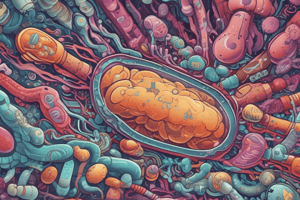Podcast
Questions and Answers
Bacteria can only be found in soil and water.
Bacteria can only be found in soil and water.
True (A)
There are around 50 million bacteria in every gram of surface soil.
There are around 50 million bacteria in every gram of surface soil.
True (A)
We would not survive without bacteria because they help degrade the food we eat.
We would not survive without bacteria because they help degrade the food we eat.
True (A)
Bacteria protect against pathogens.
Bacteria protect against pathogens.
Bacteria are large organisms that can be seen with the naked eye.
Bacteria are large organisms that can be seen with the naked eye.
Antibiotics do not work against viruses.
Antibiotics do not work against viruses.
Penicillin was discovered by Alexander Fleming in 1928.
Penicillin was discovered by Alexander Fleming in 1928.
Antibiotics can treat viral infections.
Antibiotics can treat viral infections.
The flu is an example of a bacterial infection.
The flu is an example of a bacterial infection.
Antibiotics should be taken for the common cold.
Antibiotics should be taken for the common cold.
Urinary tract infections are examples of bacterial infections.
Urinary tract infections are examples of bacterial infections.
Broad spectrum antibiotics are effective against one or a few types of bacteria.
Broad spectrum antibiotics are effective against one or a few types of bacteria.
Inappropriate use of antibiotics has contributed to antibiotic resistance.
Inappropriate use of antibiotics has contributed to antibiotic resistance.
We can acquire disease-causing bacteria from food and water.
We can acquire disease-causing bacteria from food and water.
Antibiotic resistance has been linked to the massive use of antibiotics.
Antibiotic resistance has been linked to the massive use of antibiotics.
Antibiotics are effective against viruses.
Antibiotics are effective against viruses.
Macrolides prevent bacteria from multiplying by keeping bacteria from making proteins.
Macrolides prevent bacteria from multiplying by keeping bacteria from making proteins.
Cephalosporins kill bacteria by preventing formation of the bacterial cell wall.
Cephalosporins kill bacteria by preventing formation of the bacterial cell wall.
Fluoroquinolones kill bacteria by preventing formation of the bacterial cell wall.
Fluoroquinolones kill bacteria by preventing formation of the bacterial cell wall.
Amoxicillin/clavulanate is a combination of a penicillin and a beta-lactamase inhibitor.
Amoxicillin/clavulanate is a combination of a penicillin and a beta-lactamase inhibitor.
Tetracyclines prevent bacteria from multiplying by keeping bacteria from making proteins.
Tetracyclines prevent bacteria from multiplying by keeping bacteria from making proteins.
Nitrofurantoin is effective against bacteria by keeping them from making folic acid.
Nitrofurantoin is effective against bacteria by keeping them from making folic acid.
Antibiotics have a significant effect against uncomplicated sinus infections and ear infections.
Antibiotics have a significant effect against uncomplicated sinus infections and ear infections.
Antibiotic resistance is the ability of bacteria to protect themselves against the effects of an antibiotic.
Antibiotic resistance is the ability of bacteria to protect themselves against the effects of an antibiotic.
In large bacterial populations, there are often no resistant bacteria.
In large bacterial populations, there are often no resistant bacteria.
Antibiotic resistant bacteria can transfer their resistance to other bacteria.
Antibiotic resistant bacteria can transfer their resistance to other bacteria.
Sensitive strains of bacteria multiply when antibiotics are added.
Sensitive strains of bacteria multiply when antibiotics are added.
Bacteria are experts at surviving in changing environments.
Bacteria are experts at surviving in changing environments.
Taking antibiotics when you don’t need them contributes to antibiotic resistance.
Taking antibiotics when you don’t need them contributes to antibiotic resistance.
Viruses cause most sore throats, so antibiotics will help treat them.
Viruses cause most sore throats, so antibiotics will help treat them.
It is important to only take antibiotics when your provider prescribes them.
It is important to only take antibiotics when your provider prescribes them.
Using someone else’s antibiotics if you miss a dose is a good practice.
Using someone else’s antibiotics if you miss a dose is a good practice.
Mutated bacteria become resistant to antibiotics.
Mutated bacteria become resistant to antibiotics.
An antibiotic sensitivity test can help determine which antibiotic will be most effective in treating an infection.
An antibiotic sensitivity test can help determine which antibiotic will be most effective in treating an infection.
Antibiotic resistance can make once easily treatable diseases turn into serious illnesses.
Antibiotic resistance can make once easily treatable diseases turn into serious illnesses.
Antibiotic resistance decreases the effectiveness of standard antibiotics against certain bacteria.
Antibiotic resistance decreases the effectiveness of standard antibiotics against certain bacteria.
An antibiotic sensitivity test is performed by taking a blood sample.
An antibiotic sensitivity test is performed by taking a blood sample.
Antibiotic sensitivity testing is also referred to as antimicrobial susceptibility testing.
Antibiotic sensitivity testing is also referred to as antimicrobial susceptibility testing.
Antibiotic resistance leads to treatment failures.
Antibiotic resistance leads to treatment failures.
Antibiotic resistance does not threaten modern medical procedures.
Antibiotic resistance does not threaten modern medical procedures.
Antibiotic resistance imposes a major economic burden on society.
Antibiotic resistance imposes a major economic burden on society.
Antibiotic resistant bacteria do not cause many deaths around the world.
Antibiotic resistant bacteria do not cause many deaths around the world.
Antibiotic resistance is a problem.
Antibiotic resistance is a problem.
The genetic makeup of a bacterium can spontaneously change, leading to antibiotic resistance.
The genetic makeup of a bacterium can spontaneously change, leading to antibiotic resistance.
Contagious drug-resistant bacterial infections can be transmitted from person to person.
Contagious drug-resistant bacterial infections can be transmitted from person to person.
Staphylococcus aureus is not associated with a high number of deaths from antibiotic-resistant infections.
Staphylococcus aureus is not associated with a high number of deaths from antibiotic-resistant infections.
The bacterium Klebsiella pneumoniae is among the deadliest antibiotic-resistant bacteria globally.
The bacterium Klebsiella pneumoniae is among the deadliest antibiotic-resistant bacteria globally.
Few treatments exist for infections caused by resistant bacteria, but it doesn't become harder to treat these infections over time.
Few treatments exist for infections caused by resistant bacteria, but it doesn't become harder to treat these infections over time.
Handwashing is an important step in practicing good hygiene to combat antibiotic resistance.
Handwashing is an important step in practicing good hygiene to combat antibiotic resistance.
Antibiotics are effective against viral infections.
Antibiotics are effective against viral infections.
Healthcare providers and policymakers are the only ones responsible for combating antibiotic resistance.
Healthcare providers and policymakers are the only ones responsible for combating antibiotic resistance.
Bacterial and viral infections can have similar symptoms.
Bacterial and viral infections can have similar symptoms.
Using antibiotics when they are not needed contributes to antibiotic resistance.
Using antibiotics when they are not needed contributes to antibiotic resistance.
Flashcards are hidden until you start studying
Study Notes
Bacteria
- Bacteria are small, microscopic organisms found in most environments, including soil, water, and the human body.
- There are approximately 50 million bacteria in every gram of surface soil.
- Bacteria play a crucial role in degrading the food we eat and protecting against pathogens.
Disease-Causing Bacteria
- Some bacteria can cause infections and even death.
- Infections can be acquired from outside the body through sources like other humans, animals, food, and water.
- Examples of bacterial infections include pneumonia, blood stream infections, urinary tract infections, wound infections, and gonorrhea.
Antibiotics
- Antibiotics are medicines used to treat bacterial infections.
- Examples of antibiotics include penicillin and Ciprofloxacin.
- Penicillin was discovered by Alexander Fleming in 1928 and introduced as a medicine in the 1940s.
- Antibiotics can have either a broad or narrow spectrum, with broad spectrum antibiotics effective against many types of bacteria and narrow spectrum antibiotics effective against one or a few types of bacteria.
Antibiotics Effectiveness
- Antibiotics are effective against certain bacterial infections, but they have only marginal effects on other infections, such as uncomplicated sinus infections and ear infections.
- The body's immune system can often take care of infections without antibiotics, but for some infections, antibiotics are life-saving medicines.
Antibiotics Classification
- Antibiotics can be classified into different classes, including:
- Penicillins: kill bacteria by preventing the formation of the bacterial cell wall.
- Macrolides: prevent bacteria from multiplying by keeping them from making proteins.
- Cephalosporins: kill bacteria by preventing the formation of the bacterial cell wall.
- Fluoroquinolones: kill bacteria by keeping them from making DNA.
- Beta-lactams with increased activity: combinations of penicillin or cephalosporin and a beta-lactamase inhibitor that protect the penicillin or cephalosporin from being destroyed by an enzyme produced by some bacteria.
- Tetracyclines: prevent bacteria from multiplying by keeping them from making proteins.
- Trimethoprim-sulfamethoxazole: work together to inhibit the ability of bacteria to make folic acid, which is necessary for making DNA and proteins.
- Urinary anti-infectives: depends on the specific drug, but can kill bacteria or prevent them from multiplying by keeping them from making DNA, proteins, and the bacterial cell wall.
- Lincosamides: prevent bacteria from multiplying by keeping them from making proteins.
Antibiotic Resistance
- Antibiotics do not work against viruses.
- Antibiotic resistance is the ability of bacteria to protect themselves against the effects of an antibiotic.
- Bacteria are experts at surviving in changing environments, and in large bacterial populations, there are often a few resistant bacteria.
- Antibiotic resistance occurs when a few bacteria in a population have mutated to become resistant to antibiotics.
- The resistant bacteria can then grow and multiply, and even transfer drug-resistance to other bacteria.
Consequences of Antibiotic Resistance
- Antibiotic resistance leads to treatment failures.
- Antibiotic resistance threatens our ability to perform modern medical procedures.
- Antibiotic resistance imposes a major economic burden on society.
- Antibiotic-resistant bacteria already cause many deaths around the world.
Causes of Antibiotic Resistance
- Overuse of antibiotics: taking antibiotics when not necessary contributes to antibiotic resistance.
- Misuse of antibiotics: bacteria can take advantage of any opportunity to multiply, leading to mutation and resistance.
- Spontaneous resistance: genetic mutations in bacteria can occur naturally.
- Transmitted resistance: contagious drug-resistant bacterial infections can be passed to others.
Deadly Antibiotic-Resistant Bacteria
- Escherichia coli (E. coli)
- Staphylococcus aureus (S. aureus)
- Klebsiella pneumoniae (K. pneumoniae)
- Streptococcus pneumoniae (S. pneumoniae)
- Acinetobacter baumannii (A. baumannii)
- Pseudomonas aeruginosa (P. aeruginosa)
Antibiotic Sensitivity Test
- An antibiotic sensitivity test can help find the most effective antibiotic to treat an infection.
- The test can also help find a treatment for antibiotic-resistant infections.
Combating Antibiotic Resistance
- Practice good hygiene: handwashing and other measures can help prevent infections.
- Only take antibiotics when necessary: avoid taking antibiotics for viral infections, and only take them when prescribed by a healthcare provider.
Studying That Suits You
Use AI to generate personalized quizzes and flashcards to suit your learning preferences.




